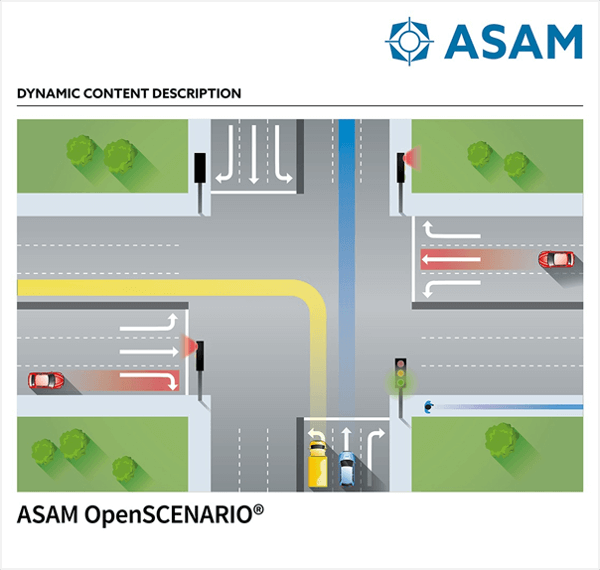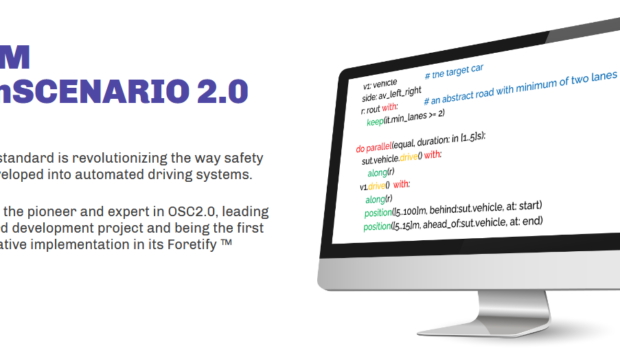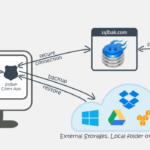What is ASAM OpenSCENARIO 2.0 and its importance in simulation applications?
The demand for more advanced testing and validation of ADAS and autonomous driving systems is expanding exponentially as autonomous cars evolve. It is projected that simulation-based testing would eventually replace the unattainable objective of driving billions of kilometers for validation reasons. Several businesses have previously reported their usage of thousands of simulation-based tests for autonomous system validation.
The release of OpenSCENARIO V2.0 was scheduled for November 2021. OpenSCENARIO V2.0 is developed by the Association for Standardization of Automation and Measuring Systems (ASAM) as a standard for expressing scenarios with dynamic content in advanced driver-assistance systems (ADAS) and autonomous vehicle (AV) development.
In ADAS and AV testing and development, a scenario is the dynamic content of a simulation. Scenarios are critical in testing, verifying, and certifying the safety of autonomous driving systems. To validate a functional requirement, simulation operations, testing, and validation teams must test it against a potentially massive parameter space.
Teams can specify the whole test space of the system by constraining this parameter space to the autonomous system’s operational design domain (ODD). To adequately evaluate the autonomous system in the whole test area, the PEGASUS technique advises employing multiple abstraction levels of scenarios.
What Are The Drawbacks of OpenSCENARIO 1.0?
OpenSCENARIO 1.0 is a low-level and concrete specification format intended primarily for use by simulation tools. Users who write maneuver descriptions and tests want a greater degree of abstraction and maybe other methods to express themselves than the existing thorough XML-format of OpenSCENARIO 1.0.
There are several suggestions given about how to convey maneuver descriptions at a higher level of abstraction, including interfaces to general-purpose computer languages, textual styled natural-language scenario descriptions, and the creation of a domain-specific language (DSL).
A key consideration is the ability for domain experts to directly compose and assess scenarios without the need of particular technology, while yet having a fully formalized description that can be precisely interpreted and executed by computers as well as people.
Based on the idea group’s recommendations, OpenSCENARIO 2.0 is intended to be based on the concept of a domain-specific language, which should allow all levels of scenario description, from the extremely abstract to the very concrete, in an acceptable manner.
The OpenSCENARIO 2.0 principles take established OpenSCENARIO 1.0 features and capabilities, such as its event-based scenario execution paradigm, and position them in a more generic and expressive language framework to serve as the foundation for both incremental upgrades and more revolutionary advancements.
What Gives OpenSCENARIO 1.0 an edge over OpenSCENARIO 2.0?
In comparison to OpenSCENARIO 1.0, a more precise set of actions and characteristics for the necessary simulation models must be provided in order to provide a more thorough scenario description and increase exchangeability.

Aside from such enhancements, the proposed domain-specific language allows for the design of more complicated situations by allowing for the flexible composition and parametrization of component scenarios in ways that allow for realistic, emergent behavior. This will allow for extensive testing and verification of new, sophisticated hardware and software systems, as well as their interactions.
OpenSCENARIO 2.0 is designed to be a complete superset of OpenSCENARIO 1.0’s features. This implies that the release version of OpenSCENARIO 2.0 will contain a migration route for OpenSCENARIO 1.x situations to OpenSCENARIO 2.0.
Because OpenSCENARIO 2.0 is designed to be a real superset of OpenSCENARIO 1.x, converting OpenSCENARIO 2.0 situations to OpenSCENARIO 1.x is generally not feasible. However, a subset of OpenSCENARIO 2.0 that maps to the feature set of OpenSCENARIO 1.x will be viable to convert.
OpenSCENARIO V2.0 will allow abstract, logical, and concrete situations to promote inter-tool interoperability. This will make it easy to move scenarios with varying degrees of abstraction between tools. It will also enable OpenSCENARIO V2.0 to support a broader set of AV development use cases.
By designing abstract scenarios and extracting logical and concrete situations from those abstract scenarios, simulation operations, testing, and validation teams will be able to validate functional requirements. All layers of abstraction will utilize the same standardized language and will be easily transferred between tools.
















